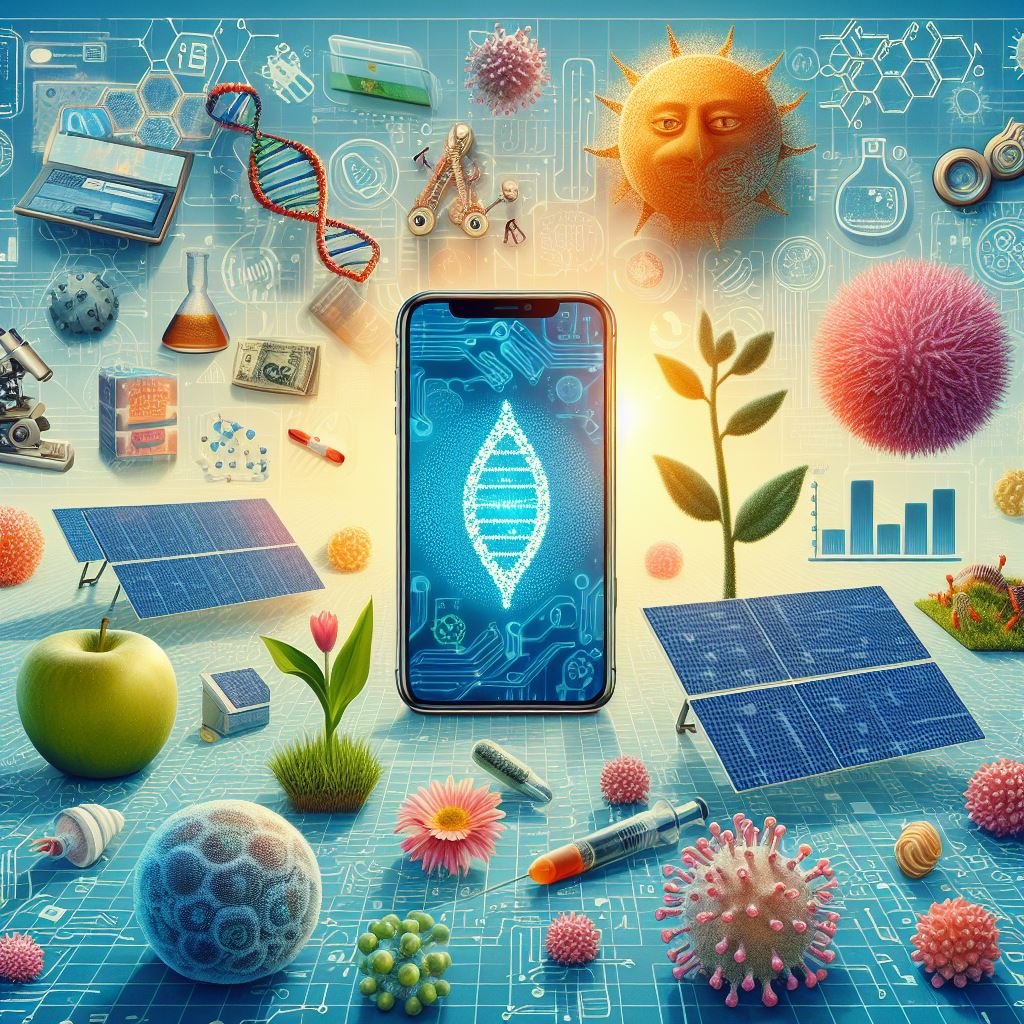Science surrounds us, shaping our world and impacting our lives in countless ways. From the pocket-sized computers we carry to the mysteries of our own bodies, scientific discoveries fuel innovation, answer age-old questions, and continue to push the boundaries of human knowledge. Let’s delve into ten fascinating facts that showcase the wonders of science:
1. Your Smartphone: A Symphony of Science
The unassuming device in your pocket is a marvel of materials science and engineering. The smooth, responsive touchscreen utilizes a combination of conductive and non-conductive layers that react to your finger’s electrical signals. These layers are incredibly thin, measured in nanometers (billionths of a meter), requiring precise engineering to function flawlessly.
Beneath the surface, miniaturized circuits house billions of transistors, the fundamental building blocks of electronic devices. These transistors are constantly shrinking in size, allowing manufacturers to pack ever-increasing processing power into smartphones. The lithium-ion batteries that power these devices are another scientific marvel, constantly evolving to provide longer life and faster charging times. They rely on the movement of lithium ions between electrodes, generating the electricity that keeps your phone humming.
2. Citizen Science: The Power of the Crowd
Citizen science flips the script on traditional research, allowing the public to contribute valuable data to scientific projects. This democratization of science empowers ordinary people to participate in groundbreaking discoveries. For instance, projects like eBird allow anyone to log bird sightings, contributing to a massive database that helps researchers track bird migrations and monitor population health. Galaxy Zoo enlists citizen scientists to classify galaxies from digitized images, helping astronomers categorize millions of celestial objects and unlock the secrets of the universe.
The beauty of citizen science lies in its accessibility. Often, participation requires nothing more than a smartphone and an internet connection. This allows anyone, regardless of scientific background, to contribute to the advancement of knowledge.
3. The Delicious Side of Chemistry: Food Science Magic
Food science is the fascinating intersection of chemistry and culinary arts. It explains the scientific principles behind the everyday processes that transform raw ingredients into delectable dishes. Baking soda, a common kitchen ingredient, is a great example. When combined with an acidic liquid (like buttermilk or yogurt), baking soda releases carbon dioxide gas. This gas gets trapped in the batter, causing it to rise and creating fluffy cakes, cookies, and breads.
Onions, on the other hand, contain a volatile sulfur compound called sulfenic acid. When you cut an onion, these compounds are released into the air and react with the water in your eyes, forming sulfuric acid. This irritation triggers your tear ducts, leading to the familiar (and slightly embarrassing) watery eyes. Understanding the underlying science behind these everyday culinary experiences can deepen your appreciation for the intricate dance of chemistry that occurs in your kitchen.
4. The Future of Medicine: Robotics in the Operating Room
The field of medicine is constantly evolving, and robotics is playing an increasingly prominent role. Surgical robots, controlled by skilled surgeons, offer advantages over traditional laparoscopic surgery. These robots provide enhanced dexterity, allowing surgeons to perform minimally invasive procedures with greater precision and control. This translates to benefits for patients, including faster recovery times, reduced scarring, and potentially improved outcomes.
Beyond surgery, robots are also being used in other areas of medicine. Rehabilitation robots assist patients with physical therapy, helping them regain strength and mobility. Pharmaceutical robots automate the complex and delicate task of drug preparation, minimizing the risk of human error. As robotics technology continues to advance, its impact on healthcare is sure to become even more significant.
5. Sleep: Unraveling the Mystery of Rest
Sleep is essential for our physical and mental well-being. During sleep, our bodies repair tissues, consolidate memories, and regulate hormones. Yet, many people struggle to get a good night’s rest. To understand sleep better, let’s explore the science behind it.
Our sleep cycles are governed by a tiny region in our brain called the suprachiasmatic nucleus (SCN). This “internal clock” is responsible for regulating our circadian rhythm, the natural sleep-wake cycle. The SCN is sensitive to light, particularly blue light emitted from electronic devices. Exposure to blue light in the evening can suppress the production of melatonin, a hormone that signals sleepiness.
To promote better sleep, it’s crucial to establish a consistent sleep schedule and create a relaxing bedtime routine. Limiting exposure to blue light before bed, such as by turning off electronic devices or using blue light filters, can also significantly improve sleep quality.
6. The Microscopic World Within Us: The Human Microbiome
Our bodies are teeming with trillions of microorganisms, bacteria, fungi, and other microbes that collectively form the human microbiome. These microbes play a crucial role in our health, influencing digestion, immune function, and even our mood. A healthy microbiome is essential for overall
well-being. It helps break down food, absorbs nutrients, and protects us from harmful pathogens. Research suggests that imbalances in the microbiome may contribute to various health conditions, including digestive disorders, obesity, and even certain autoimmune diseases.
Scientists are still unraveling the complexities of the human microbiome, but one thing is clear: these tiny organisms play a significant role in our health. Maintaining a balanced microbiome through a healthy diet rich in fiber, probiotics (beneficial bacteria found in yogurt and fermented foods), and limited processed foods is crucial for optimal health.
7. The Unseen Force: Gravity’s Grip on the Universe
Gravity, the invisible force that keeps us grounded, is one of the fundamental forces of nature. It governs the motion of everything in the universe, from the tiniest particles to galaxies billions of light-years away.
Sir Isaac Newton first described gravity, proposing that every object in the universe attracts every other object with a force proportional to their masses and inversely proportional to the square of the distance between them. This simple equation explains everything from why we stay on Earth to the motion of planets around the sun.
Gravity also plays a crucial role in the formation of stars and galaxies. The immense gravitational pull of massive clouds of gas and dust causes them to collapse, igniting nuclear fusion and creating stars. These stars, in turn, eventually explode in spectacular supernovas, scattering heavier elements throughout the universe, which later form new generations of stars and planets.
8. The Green Revolution: Genetically Modified Organisms (GMOs)
Genetically modified organisms (GMOs) are plants or animals whose genetic makeup has been altered to introduce desired traits. These modifications can improve crop yields, resistance to pests and diseases, or even nutritional value.
The development of GMOs has sparked controversy, with concerns around potential environmental impacts and unintended consequences. However, scientific research suggests that properly regulated GMOs can be a safe and effective tool for improving food production and nutrition.
The debate surrounding GMOs highlights the importance of responsible scientific development and public education. It’s crucial to have a clear understanding of the science behind GMOs and to engage in open discussion about the ethical considerations surrounding their use.
9. The Power of the Sun: Harnessing Renewable Energy
The sun is a powerhouse, radiating immense amounts of energy in the form of light and heat. This energy can be harnessed through renewable technologies like solar panels and solar thermal collectors, offering a clean and sustainable alternative to fossil fuels.
Solar panels convert sunlight into electricity through the photovoltaic effect. As sunlight hits the solar cells, it excites electrons, creating a flow of electricity. Solar thermal collectors, on the other hand, capture the sun’s heat to generate hot water or steam, which can be used for various applications, including heating buildings and powering turbines to produce electricity.
The cost of solar technology has declined significantly in recent years, making it a more viable option for homes and businesses. As solar energy continues to become more affordable and efficient, it has the potential to play a major role in reducing greenhouse gas emissions and combating climate change.
10. Artificial Intelligence: Machines That Learn
Artificial intelligence (AI) is a broad field of computer science focused on creating intelligent machines that can learn and perform tasks that typically require human intelligence. AI encompasses a wide range of technologies, from machine learning algorithms that can identify patterns in data to natural language processing that allows computers to understand and respond to human language.
AI has the potential to revolutionize many aspects of our lives. In healthcare, AI can be used to analyze medical images and diagnose diseases with greater accuracy. In transportation, self-driving cars powered by AI could significantly reduce traffic accidents. AI can also be used to personalize our experiences, from recommending products online to tailoring news feeds to our interests.
However, the development of AI also raises questions about ethics and potential risks. It’s crucial to ensure that AI systems are developed and used responsibly, with a focus on human well-being and safety.
Conclusion
Science is a continuous exploration of the world around us and within us. These ten facts offer a glimpse into the fascinating discoveries and ongoing research that shape our understanding of the universe. From the intricate workings of our bodies to the vastness of space, science continues to push the boundaries of knowledge and unlock new possibilities for the future. As we continue to learn and explore, the wonders of science will undoubtedly continue to amaze and inspire us.



